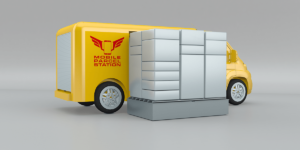Mobility think-tank Rinspeed from Switzerland presents CitySnap, the latest EV in their Snap Motion line. This time, they constructed the body to accommodate highly automated deliveries and most mobile pick-ups.
According to Rinspeed, these modular delivery vehicles will not only significantly reduce expenses on the last-mile but also reduce the number of delivery vehicles by up to 50 per cent.
City Snap is supposed to, well, deliver all those advantages primarily through automation and more flexibility. While Rinspeed admits that automated driving will be “a long time in coming” and designed the CitySnap for a human driver initially, there are other areas already ripe for machines to take over. In this case, these cover unloading parcel stations and Rinspeed adds the picking and packing of these parcel stations would offer further automation potential.
That is not far from other such concepts. Yet the leading idea for Rinspeed’s proposal lies in eliminating one of the highest inefficiencies in deliveries – wait times and/or undelivered parcels. The company calls those “just-in-time meetings of recipient and delivery vehicle” and finds them “unsuitable because it is exceedingly difficult to predict traffic and human behaviour.” In other words, if the vehicle waits until the parcel recipient can get there, the delivery rate falls, and the delivery costs rise accordingly. At the same time, if the driver leaves and has to reattempt delivery, nobody has gained anything either.
– ADVERTISEMENT –
CitySnaps instead includes parcel stations on wheels, that can be dropped at convenient locations around a neighbourhood depending on the location of the receiver. Rinspeed envisions “easily accessible and well-lit places that allow the end customers to get to their parcels in a safe environment.”
The CitySnap delivery vehicles would then independently distribute, set down and pick up the mobile parcel stations, leading to the afore-mentioned cost savings by increasing the efficiency of inner-city logistics.
They did not relay much technical information. Yet the Snap concept has been around since 2018 when it became the Snap Motion spin-off with offices in Europe and Silicon Valley.
At the heart of each of the designs that followed is a flat skateboard platform that hosts the electric motor and battery. Add to this exchangeable cabins which Rinspeed calls pods that can contain anything from passenger seating to a mobile doctor’s office. In the case of the CitySnap, this now appears a more conventional delivery pod. At least this is what the renderings show.
Rinspeed says they want to present the proof-of-concept CitySnap in spring 2021. Talks with potential pilot partners were already underway, the company added.

